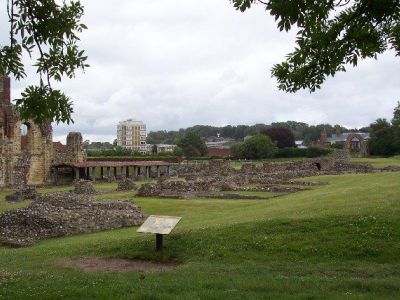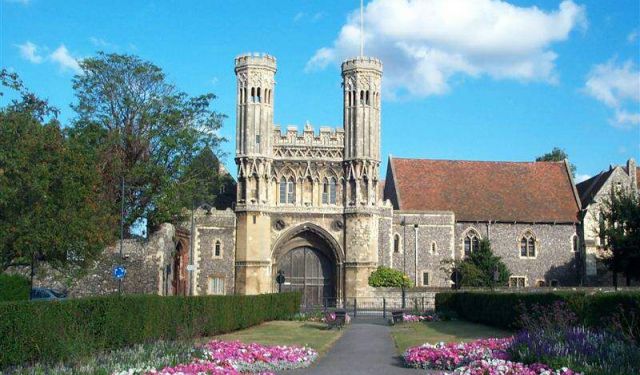St. Augustine's Abbey, Canterbury (must see)
Saint Augustine arrived in England in 597. Pope Gregory I sent Saint Augustine to convert the Anglo-Saxons to Christianity. The King of Kent, Ethelbert, was married to Queen Bertha, who was already a Christian. King Ethelbert ordered the construction of a splendid church, and construction on Saint Augustine's Abbey began in 598. At that time, the Abbey was dedicated to Saints Peter and Paul.
While most structures in the area were quickly built with wood building materials, Saint Augustine wanted to build a church with stone to emulate the churches of Rome. Thus, Saint Augustine's Abbey became the main religious building in Kent. In addition, Saint Augustine's Abbey became known as a missionary school where learning and knowledge were celebrated.
Saint Augustine became the first Archbishop of Canterbury and was buried in Saint Augustine's Abbey.
In 978, Dunstan, the Archbishop of Canterbury, renovated and expanded the Abbey. Finally, he re-dedicated the Abbey to Saint Augustine, and the church became known as Saint Augustine's Abbey.
The Abbey gatehouse was rebuilt in 1309 and became known as Fyndon Gate. The chamber in the gatehouse was used as the state bed-chamber, and royalty stayed there on their travels. For example, King Charles I and Queen Henrietta Maria stayed here after their Canterbury Cathedral wedding in 1625. In 1660, Charles II and the Dukes of York and Gloucester stayed here.
Freedom Gate faces Lady Wootton's Green. This small square houses statues of King Ethelberht and Queen Bertha.
King Herny VIII dismantled England's monasteries to make way for the new Church of England. In 1538, Saint Augustine's Abbey became the property of the Crown after 940 years of existing as a monastery. Some of the Abbey was initially used as a residence by royal family members. Throughout the centuries, the Abbey was dismantled.
In 1844, Alexander James Beresford Hope bought the ruins and remaining buildings and began to preserve them. Unfortunately, the site was heavily damaged by World War II bombs.
Saint Augustine's Missionary College survived and is currently used by the King's School, Canterbury.
Why You Should Visit:
Saint Augustine's Abbey is part of the Canterbury World Heritage Site, along with the cathedral and Saint Martin's Church. Visitors can see the ruins of Saint Augustine's Abbey, as well as several important graves. Saint Augustine, Ethelberht of Kent, and early Archbishops of Canterbury are buried on the site.
Tips:
Visit the small on-site museum to get an idea of what the Abbey looked like 1,000 years ago. The museum also has audio tours of the ruins available.
While most structures in the area were quickly built with wood building materials, Saint Augustine wanted to build a church with stone to emulate the churches of Rome. Thus, Saint Augustine's Abbey became the main religious building in Kent. In addition, Saint Augustine's Abbey became known as a missionary school where learning and knowledge were celebrated.
Saint Augustine became the first Archbishop of Canterbury and was buried in Saint Augustine's Abbey.
In 978, Dunstan, the Archbishop of Canterbury, renovated and expanded the Abbey. Finally, he re-dedicated the Abbey to Saint Augustine, and the church became known as Saint Augustine's Abbey.
The Abbey gatehouse was rebuilt in 1309 and became known as Fyndon Gate. The chamber in the gatehouse was used as the state bed-chamber, and royalty stayed there on their travels. For example, King Charles I and Queen Henrietta Maria stayed here after their Canterbury Cathedral wedding in 1625. In 1660, Charles II and the Dukes of York and Gloucester stayed here.
Freedom Gate faces Lady Wootton's Green. This small square houses statues of King Ethelberht and Queen Bertha.
King Herny VIII dismantled England's monasteries to make way for the new Church of England. In 1538, Saint Augustine's Abbey became the property of the Crown after 940 years of existing as a monastery. Some of the Abbey was initially used as a residence by royal family members. Throughout the centuries, the Abbey was dismantled.
In 1844, Alexander James Beresford Hope bought the ruins and remaining buildings and began to preserve them. Unfortunately, the site was heavily damaged by World War II bombs.
Saint Augustine's Missionary College survived and is currently used by the King's School, Canterbury.
Why You Should Visit:
Saint Augustine's Abbey is part of the Canterbury World Heritage Site, along with the cathedral and Saint Martin's Church. Visitors can see the ruins of Saint Augustine's Abbey, as well as several important graves. Saint Augustine, Ethelberht of Kent, and early Archbishops of Canterbury are buried on the site.
Tips:
Visit the small on-site museum to get an idea of what the Abbey looked like 1,000 years ago. The museum also has audio tours of the ruins available.
Want to visit this sight? Check out these Self-Guided Walking Tours in Canterbury. Alternatively, you can download the mobile app "GPSmyCity: Walks in 1K+ Cities" from Apple App Store or Google Play Store. The app turns your mobile device to a personal tour guide and it works offline, so no data plan is needed when traveling abroad.
St. Augustine's Abbey on Map
Sight Name: St. Augustine's Abbey
Sight Location: Canterbury, England (See walking tours in Canterbury)
Sight Type: Religious
Guide(s) Containing This Sight:
Sight Location: Canterbury, England (See walking tours in Canterbury)
Sight Type: Religious
Guide(s) Containing This Sight:
Walking Tours in Canterbury, England
Create Your Own Walk in Canterbury
Creating your own self-guided walk in Canterbury is easy and fun. Choose the city attractions that you want to see and a walk route map will be created just for you. You can even set your hotel as the start point of the walk.
Canterbury Cathedral and Grounds
Canterbury Cathedral, one of the oldest churches that played a crucial role in English Christianity, stands within its own walled area, surrounded by Medieval buildings and ruins.
At the heart of this ensemble rises the cathedral itself, a magnificent example of medieval architecture and a UNESCO World Heritage Site. As you enter, you'll pass through the imposing Christ Church Gate, a... view more
Tour Duration: 1 Hour(s)
Travel Distance: 0.8 Km or 0.5 Miles
At the heart of this ensemble rises the cathedral itself, a magnificent example of medieval architecture and a UNESCO World Heritage Site. As you enter, you'll pass through the imposing Christ Church Gate, a... view more
Tour Duration: 1 Hour(s)
Travel Distance: 0.8 Km or 0.5 Miles
Canterbury Introduction Walking Tour
Canterbury is a UNESCO World Heritage City and one of the most visited cities in England. Canterbury has a long history and has been occupied since Paleolithic times. It was the capital of the Celtic Cantiaci, Romans settled the area for centuries, and the site was the capital of the Kingdom of Kent.
Saint Augustine arrived in Canterbury in 597 to convert the Anglo-Saxons to Christianity. The... view more
Tour Duration: 2 Hour(s)
Travel Distance: 2.7 Km or 1.7 Miles
Saint Augustine arrived in Canterbury in 597 to convert the Anglo-Saxons to Christianity. The... view more
Tour Duration: 2 Hour(s)
Travel Distance: 2.7 Km or 1.7 Miles





